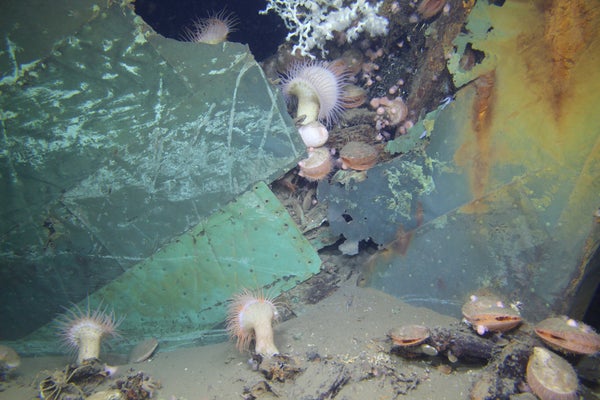Six years ago more than four million barrels of oil were discharged into the Gulf of Mexico following the Deepwater Horizon drilling platform explosion. Approximately one third of the oil ended up at the bottom of the gulf where shipwrecks lie. New findings now show that the microbial life has since thrived due to the spill and could threaten 500 years of history resting on the seafloor.
Presenting their findings at the 2016 Ocean Sciences Meeting in New Orleans last week, scientists shared results of an experiment that exposed metal disks to oil spill-like conditions, which showed that bacteria flourished and sped up metal corrosion in the presence of oil, potentially jeopardizing several hundred historic ships and their delicate ecosystems in the region impacted by the oil spill.*
In addition to being culturally and historically valuable, shipwrecks can become cornerstones of oceanic ecology. “A shipwreck will become over time an artificial reef which is a hotspot for biological diversity,” says Leila Hamdan, one of the leaders of the project and a microbial ecologist at George Mason University (G.M.U.). Microorganisms make the shipwrecks habitable by creating a surface biofilm as more and more organisms colonize the wreck. This film attracts and promotes the growth of larger organisms, such as corals. The new species in turn lure in other, more mobile species. Instead of being ghost ships, the wrecks teem with aquatic life. “Our responsibility isn’t only to protect the culturally significant resources but the ecologically significant ones as well,” Hamdan says.
On supporting science journalism
If you're enjoying this article, consider supporting our award-winning journalism by subscribing. By purchasing a subscription you are helping to ensure the future of impactful stories about the discoveries and ideas shaping our world today.
Hamdan is part of the Gulf of Mexico Shipwreck Corrosion, Hydrocarbon Exposure, Microbiology and Archaeology project, which spans multiple institutions.* Its chief goals include studying the microbial communities that crop up around shipwrecks, the part biofilms play in turning shipwrecks into artificial reefs and how these microbes respond to oil and other hydrocarbons. Part of her research included a laboratory experiment that exposes steel disks comparable in composition to the delicate shipwrecks colonized by microorganisms and then exposing them to different environmental conditions. Metal corrosion due to microorganisms is a naturally occurring process but the team wanted to understand if the presence of contaminants such as oil would accelerate the corrosion rate and potentially cause harm to these fragile systems, both ecologically and structurally.
She and her team submerged four disks into four tanks kept at 4 degrees Celsius and allowed microorganisms to colonize each one. After two weeks different contaminant treatments were added to three of the four tanks. These treatments were oil alone, a mixture of dispersant and oil, and dispersant alone—all meant to simulate the conditions of the Deepwater Horizon spill. “We found that relative to the control there was more corrosion on the oil treatment but also on the oil/dispersant,” says Jennifer Salerno, a postdoctoral microbial ecologist at G.M.U. who led the experiment. The dispersant used in the Deepwater Horizon spill, COREXIT, broke down the oil spill into smaller droplets so that microorganisms could better consume it and made these droplets sink, rather than cling to the coastlines and impact wildlife. Although the compound was never tested for use below the surface, it was applied to both the surface above the spill and at the site of the broken wellhead gushing oil, at a depth of about 1,500 meters. Around 7.6 million liters of COREXIT were used during the Deepwater Horizon spill.
Although the team has not demonstrated that the corrosion of disks in the presence of oil would necessarily translate to shipwreck corrosion, the lab test designed to serve as a proxy for what may have happened to the shipwrecks shows that is a definite possibility. “There are constituents in oil that are delicious to microorganisms,” Hamdan says. “That might increase the corrosion rate of a ship. If that happens, we might find that the actual longevity of a historical shipwreck might be shortened because the microbes that are present are accelerating its degradation.” Understanding how human-caused contaminations, such as oil spills, impact natural ecosystems and historic resources is vital to protecting these rare sites.
*Editor's Note (3/3/16): These sentences were edited after posting—the first, to correct the estimated number of ships jeopardized by the oil; the second, to correct the number of institutions supporting the project, which is principally funded by the U.S. Bureau of Ocean Energy Management.
